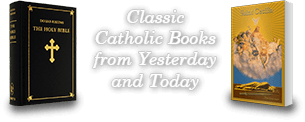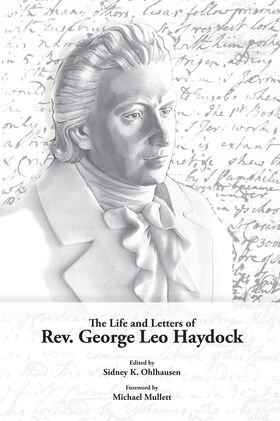Categories
Information
Sidney Ohlhausen - Illustrated - Softcover - 462 pages
This collection of documents and letters grant us an intimate look into the life of an extraordinary priest.
Rev. Haydock is most often remembered today as the author of the famous “Haydock” bible which contains the Douay-Rheims text along with the copious footnotes and commentary by Haydock himself. His purpose was not merely to give the persecuted Catholics of England the best in scriptural text and exegesis taken from the Fathers and Doctors for their own education and edification, but also to give them scholarly ammunition to assist them in the conversion of their protestant family and friends who had been so confused by the various heretical texts and sermons available to them.
The life of Rev. George Leo Haydock (1774–1849) neatly enclosed some of the most remarkable decades in the history of the post-Reformation English Catholic community, as its lay and clerical members moved forward from an ad hoc tolerance to a fuller legal equality. Three years after Haydock’s death, in 1852 St John Newman (1801–90) was to hail the period that took in his own conversion in 1845 as embracing a ‘second spring’, in which England’s Catholic Church re-emerged from centuries of oppression and obscurity, since the Tudor Reformation of the 16th century.
Foreword
It is true that the years prior to 1774 had seen the emergence of many of the features of the English Church as Haydock was to leave it at his death. For example, the urbanisation that characterised the Victorian Catholic Church was already evident in the 18th century, especially in the case of London, while the benign negligence of the authorities in suspending the operation of the harsh penal laws paved the way for their later repeal and replacement by equality before the law. Even so, and while some of the outlines of the mid-Victorian English Catholic community are traceable in the Georgian Church, George Leo Haydock’s lifetime did coincide with a second spring in its life, a renaissance in which he himself played a significant role. The rebirth of the English Catholic community between the 1770s and the 1840s can be observed in the following areas: statutory toleration through a series of Acts of Parliament; population growth, as a result largely, but not entirely, of Irish Catholic immigration; the accelerating urban re-location of the community, especially in the capital and the industrial towns of the Midlands and north, giving rise to a consequent church building boom; the ecclesiastical reorganisation of the community; and devotional shifts, including greater lay participation in the liturgy.
The reign of George III (1760-1820) began the process of the passage by the United Kingdom parliament of pro-Catholic legislation, starting with the First Catholic Relief Act, of 1778, passed four years after George Leo Haydock’s birth, allowing Catholics to acquire landed property and ending the prosecution of priests on the evidence of informers. Even this modest measure of alleviation sparked off the terrifying Gordon Riots in London in 1780, proof that not far beneath the surface of English life lurked the legacy of centuries of anti-Catholic propaganda and bigotry. Many parliamentarians and government ministers shared these prejudices, and demanded from the Catholics proofs, in the form of oaths of their loyalty to the Protestant state, and other tests of allegiance. A second Relief Act, in 1791, granted freedom of worship and allowed Catholics to practice as lawyers, but a further barrier against the achievement of civil and political rights, as well as religious toleration, remained in place in the shape of prohibitions against Catholics voting in parliamentary elections or standing for parliament. A party within the Catholic lay elite, labeled ‘Cisalpines’ (oriented away from papal Rome) was prepared to deny papal authority, even conceding a veto to the crown in the selection of bishops, in order to achieve full civil rights. They were trenchantly opposed by the clerical leader of the Ultramontane (looking beyond the Alps, to Rome), the episcopal vicar general of the Midland District, John Milner (1752-1826). Under pressure from overwhelmingly Catholic Ireland, which was fully united with Great Britain in 1801, full citizenship was granted by parliament in the Catholic Emancipation Act of 1829: there was no mention in the Act of a royal veto over the selection of bishops, in which the papacy remained sovereign.
The second Relief Act gave the green light to a phenomenal surge of Catholic church (strictly speaking ‘chapel’) building in England and Wales: even in the earlier decades of George Leo Haydock’s life, church building rose from an estimated 156 ten years after the passage of the 1791 Act, a further 28 between 1801 and 1811, another 28 from 1811 to 1821 and 52 more between 1821 and 1831. More and more of the country’s Catholic new churches were designed in the confident gothic style championed by the architect Augustus Welby Pugin (1812-52): the style which Haydock adopted, for which he collected the funds and which was to be opened in Penrith in Cumberland in the year after his death, following his priestly ministry there from 1839 onwards. This church-building programme was a response to the extraordinary demographic growth of the English Catholic community during George Haydock’s lifetime: while he was still a schoolboy, in 1780, the Catholic population of England and Wales stood at a tiny 70,000, but rose over the decades to reach an estimated 750,000 in the year after his death. Natural increase of the indigenous Catholic population accounted for much of this demographic rise but even before the Irish Famine migration of 1845-9 Irish Catholic immigration was altering the numerical balance, and the Catholic community in Haydock’s Penrith was largely made up of Irish paupers. The number of priests nationwide rose from 392 three years before Haydock’s birth to 826 two years after his death.
George Leo Haydock’s priestly life was lived under the administrative system of the vicars apostolic, in arrangements dating back to the Catholic reign (1685-8) of King James II, whereby a group of episcopally consecrated administrators were answerable directly to the Roman office of Propaganda Fide for the governance of large ‘districts’ of Great Britain (Rev. George Leo Haydock’s letters show how much he felt perplexed by the disciplinary regime of the vicars apostolic of the Northern District of England, Thomas Penswick [1763-1836]). It was, again, the year that followed George Leo Haydock’s death that saw a restoration of a full English hierarchy of bishops ‘in ordinary’ presiding over a number of recognisable dioceses. Despite political efforts to raise the bugbear of ‘papal aggression’ against this alteration, there was to be no more anti-Catholic disorder on the scale of the Gordon Riots, as the English Catholic community settled into what was becoming a tolerant, plural and multi-denominational wider Victorian society, one in which upper class conversions such as that of the saintly Passionist priest George Spencer (Fr Ignatius,1799-1864) eased the acceptance of the Catholic community into the national stream. George Leo Haydock’s ‘Roman Catholic’ English Church had always been as much English as it was Roman and his own work in paralleling other parish priests by providing congregational involvement in the liturgy in the vernacular, above all in the northern industrial towns, and his magnificent fully annotated edition of the whole Bible in our language accentuated the Englishness of the Victorian Church of the second spring.
Michael Mullett
University of Lancaster



